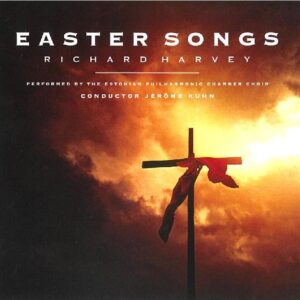
Easter Songs is Richard Harvey’s fourth CD of choral music, a startlingly original EP of three bold new settings of poems for Holy Week.
Three new choral works I See His Blood, Am I A Stone? and Easter, written on the Easter theme continue composer Richard Harvey’s creative collaboration with the Estonian Philharmonic Chamber Choir and Swiss conductor Jérôme Kuhn. The texts are by Welsh/English poet and priest George Herbert (1593–1633), the Pre-Raphaelite Christina Rossetti (1830–1894) and the Irish republican poet Joseph Mary Plunkett (1887–1916). The Easter Songs were recorded in the stunning acoustic of the medieval Fortress Cathedral at Haapsalu, in Western Estonia. The three songs are performed by the 26-member Estonian Philharmonic Chamber Choir, with an instrumental ensemble of two violins, cello and harp.
The poets chosen couldn’t be more different. Their vivid, personal verses fire the imagination and they’ve brought out the best in one of our most daringly inventive composers.
Since his schooldays in the Tiffin Boys’ School choir, Richard has been steeped in choral music’s rich heritage. The early success of his 1989 oratorio, Plague and the Moonflower, which was performed in four of England’s premier cathedrals – Canterbury, Exeter, Salisbury and St Paul’s – marked him out as a new voice in an old tradition.
Other career highlights have included his magnificent ‘Kyrie for the Magdalene’, written for the Hollywood blockbuster The Da Vinci Code and often mistakenly attributed to Richard’s friend Hans Zimmer.
‘I’ve always been drawn to that great line of religious music that runs through from Thomas Tallis via Fauré and Britten to modern composers like John Tavener and Arvo Pärt,’ he says.
‘Whatever your religion, or lack of it, churches are made for choral music. Here they’ve inspired me to experiment with what may be unfamiliar modal scales, like those of the Middle Eastern maqam, and to arrange more familiar elements in unexpected combinations. I’ve used the harp a lot in these short songs, for example – rather than organ or piano – as I love the way it complements the brilliant, soaring voices of this world class Estonian choir.’